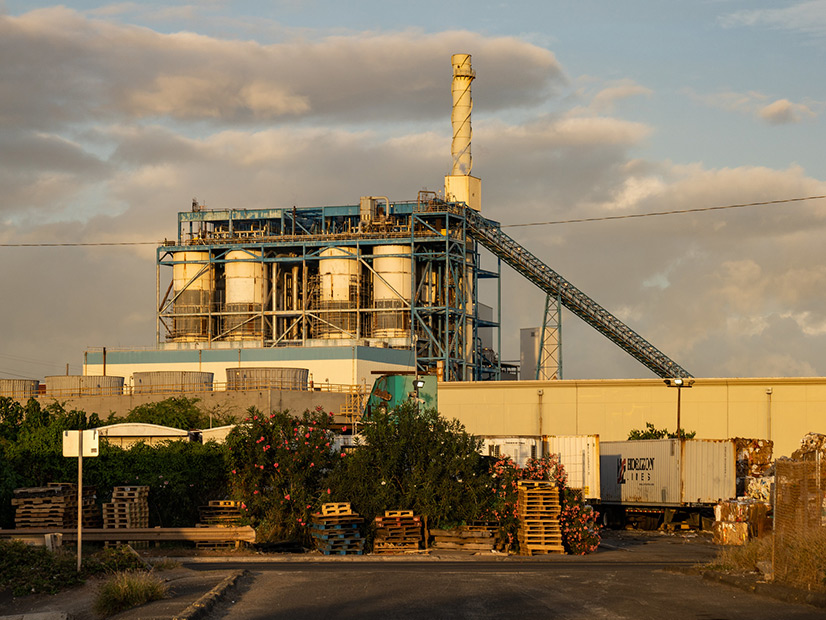
Last week’s Hawaii Public Utilities Commission status conference on the impending shutdown of the AES Hawaii Power Plant provided hope that Hawaiian Electric Company (HECO) can find a timely way to fill the void left by the closure of Oahu’s largest electricity source.
The 180-MW plant, which accounts for about 20% of Oahu’s energy needs, is slated to be decommissioned in September 2022. To make up the energy shortfall, the PUC has been aggressively pushing for renewable energy projects.
PUC members have criticized HECO for the slow pace of project development and for its plan to run an oil-fired plant — in part to charge a large battery storage system — until sufficient renewable resources come online. (See Discontent Mounts over HECO Coal Plant Closure Plans.)
During the June 21 conference, one of a series to explore accelerating deployment of renewable energy projects, developers and other stakeholders offered multiple proposals.
Scott Glenn, chief energy officer of the Powering Past Coal Task Force, said he reached out to AES before the conference to suggest retrofitting the plant to burn biomass until renewable energy projects can recover the energy shortfall.
The utility then drafted a plan that, according to AES Managing Director of Fuels John Bigalbal, could be implemented “as early as Q1 2023.” Bigalbal said AES can provide a “flexible term” of operation to cover the energy shortfall from “as short as two years to aid in the transition of the stage 1 and 2 [renewable] projects, or 10 years until the standalone battery can be substantially filled with renewable energy, or 20 years, to help with the transition to renewable energy, depending on the needs and desires of the state.”
If retrofitted, the plant would be fueled by wooden pallets from western Canada.
AES Hawaii Market Business Leader Sandra Larsen said that. “We emphasize that time is short, and we respectfully do request that any decision on whether to proceed with an evaluation be made within 30 days, if possible.”
‘Turning a Corner’
Longroad Energy said its Mahi Solar project can be brought online two to three months earlier than expected, while Clearway said it could accelerate the Mililani 1 and Waiawa projects by three months and two months, respectively.
“I didn’t think that the Mahi solar project could be accelerated because of the needs of financing, but we were able to find a way,” Longroad Energy Director of Development Wren Wescoatt said.
But acceleration comes at a cost. Longroad Energy CEO Paul Gaynor said faster timelines would force the company to spend more than two times its $21 million estimate for long-lead equipment for Mahi. “So, it can be done, it just takes money.”
But an earlier purchase of the equipment would mean the company could advance construction and have the project online by the end of July 2023, or “potentially sooner.”
Jason Smith, General Manager for Bright Canyon Energy, spoke about Kupono Solar, a proposed 42 MW solar array paired with a 168 MWh storage battery that has not yet been approved. Smith said the project would help power infrastructure for the Navy at Pearl Harbor and could be online in June 2023 if negotiations accelerate between Bright Canyon and the Navy’s selected developer, who has not yet been publicly named.
All the projects have been subject to delays, leaving PUC chair James Griffin to reiterate a persistent frustration. “The idea that the commission is supposed to make a call on this in the next 30 days, on top of all the other proposals that need a quick turnaround from the commission — I’ll just be blunt: it’s very frustrating. This situation is created by delays, and we still don’t have a clear picture on what will get through next year.”
“It seems to me that we need a call from you,” Griffin told HECO CEO Scott Seu. “… Your company needs to be very clear and say whether [extending the life of the coal plant] is necessary or not.”
“If you were to ask me if we need to extend the coal plant past September 2022, I’d say no,” Seu said.
“What I take from this is that we need to follow up after these deliberations with the developers and make sure that the timelines sync up,” Griffin said. “I haven’t heard anyone say that everything’s OK yet.”
But Griffin finished the meeting on a positive note: “I do see us turning a corner here.”

